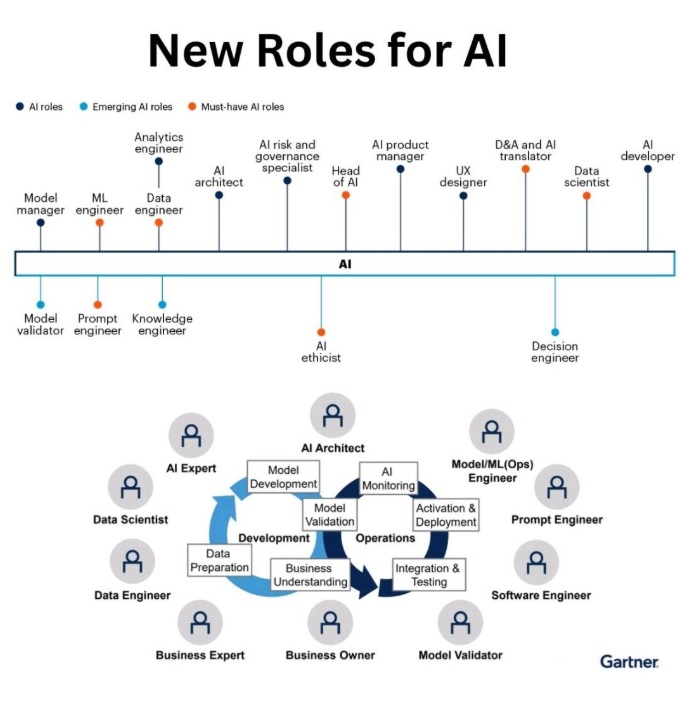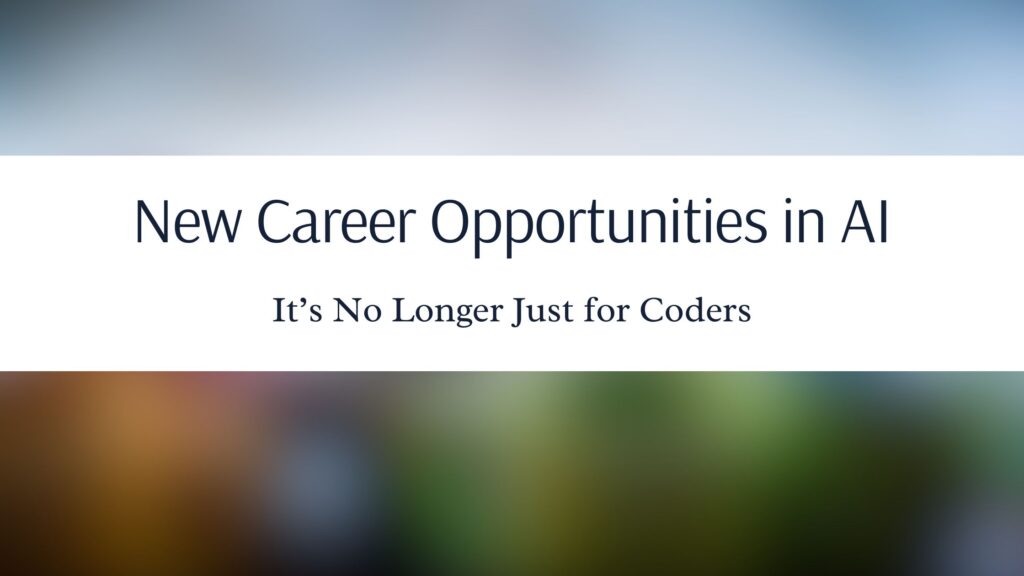Are you looking for new career opportunities in AI? When I first stepped into the world of AI, the idea of “doing AI” looked very different from what it does today.
Back then, most companies saw AI as a one-person job. You’d often hear things like:
“Just hire a data scientist. Let them build a model. That’s it.”
But I’ve seen firsthand that approach doesn’t hold up anymore.
AI has changed. It’s grown. It’s no longer just about models or code. It’s about people — with different strengths — coming together to build something meaningful.
Today, working in AI means collaboration between engineers, product thinkers, designers, domain experts, and even storytellers. It’s a team effort. And here’s something many people still don’t realize: you don’t have to be a programmer to be part of this space.
So if you’re someone curious about AI — whether you’re technical, creative, or still figuring it out — this blog is for you. I’ll walk you through how AI careers are evolving, what new roles are in demand, and how you can carve your own path in this growing field.
Let’s get into the New Career Opportunities in AI.
New Career Opportunities in AI
Why AI Career Paths Are Opening Up Like Never Before
As more companies begin to adopt AI in real ways, one thing is becoming clear: the old approach doesn’t work anymore.
They’re realizing a few important truths.
First, one person can’t do it all. You can’t just hire a single expert and expect everything to fall into place. Real AI work needs a team — with different people doing different jobs, each one focused on a specific part of the process.
Second, real-world AI is messy. It’s not just about building a model. It’s about getting it into production, making sure it works in the real world, and keeping it reliable long after launch.
Third, it’s not just about the tech Things like ethics, design, and communication play a big role. Because at the end of the day, AI isn’t just code. It affects real people in real ways.
I came across a visual from Gartner recently that captured this shift perfectly. It shows how companies, as they move from experimenting with AI to actually using it in production, need roles that simply didn’t exist five years ago.

Let me break those roles down for you — not just from reports and articles, but from what I’ve seen in my own work, my research, and my conversations with students and professionals stepping into the field.
New Career Roles in AI You Should Know About
1. Prompt Engineer
This role didn’t even exist a few years ago. Now, it’s quickly becoming one of the most in-demand jobs in the AI space.
Prompt engineers do more than just ask questions to tools like ChatGPT or Claude. They write thoughtful, clear instructions that help these models respond in useful, accurate, or creative ways. It’s not as simple as it sounds. It requires a real understanding of how these models think, and how small changes in phrasing can shift the output entirely.
The key skills you’ll need include strong writing, clear reasoning, and the patience to keep testing and refining. You don’t need to be technical, but having some understanding of how large language models work will help. And the good news is, you can learn that part along the way.
Who is this role a good fit for?
Writers, marketers, educators, support specialists — or really anyone who enjoys working with language and wants to help shape how AI communicates.
2. Model Validator
This role is all about quality control — but not in the traditional sense. It’s about making sure an AI model actually works the way it’s supposed to, without causing harm or introducing bias.
Once a model is built, it’s not ready to launch right away. That’s where model validators come in. They test the model for fairness, accuracy, and risk. They check if it treats different groups fairly, especially in high-stakes areas like healthcare, finance, or hiring. Their job is to ask tough questions, explore edge cases, and make sure the model is reliable before it goes live.
The skills that matter here are a solid understanding of statistics, strong critical thinking, and some familiarity with how bias and risk show up in AI systems. These are skills you can build with practice and the right learning path.
Who is this role a good fit for?
People who enjoy testing, digging into the details, spotting weaknesses, and thinking through real-world impact. If you’ve ever asked, “What if this goes wrong?” — this might be your lane.
3. Decision Engineer
AI isn’t just about predictions. In many cases, it also has to make choices — like which product to recommend, which route to take, or even which job application to move forward.
That’s where decision engineers come in. They design the logic behind those choices. They decide what rules the AI should follow, what limits to set, and what trade-offs are acceptable depending on the situation. It’s about building a clear decision-making structure that the AI can follow — one that makes sense for the business and for the people using it.
The skills that help here include logical thinking, systems design, and a strong understanding of business context. Experience with decision trees, rule-based systems, or basic optimization techniques is also useful — and can be picked up through real-world projects or courses.
Who is this role a good fit for?
People who like thinking through how decisions are made, enjoy breaking down complex problems into clear steps, and want to build systems that are both smart and fair.
4. AI Product Manager
AI on its own doesn’t turn into a useful product. Someone has to shape the idea, align the team, and guide it toward something that actually works. That’s the job of an AI product manager.
AI PMs take a question like “Can we use AI to automate ticket replies?” and turn it into a working solution. They figure out what needs to be built, why it matters, and how to get it done. Along the way, they collaborate with engineers, designers, prompt engineers, and business teams to make sure everyone’s on the same page.
The most important skills here are clear communication, the ability to prioritize what matters most, and strong problem framing — knowing how to define the real challenge before jumping to solutions.
Who is this role a good fit for?
People who are organized, love connecting dots between teams, and enjoy turning big ideas into something concrete and useful. If you like leading projects and making sure the right things get built at the right time, this role might be for you.
5. AI Ethicist
If you care about fairness, human rights, and how technology shapes society, this is one of the most meaningful roles you can take on in AI.
When I first heard about this role, I realized how few people were actually asking the tough questions — the ones that really matter. As an AI ethicist, you help teams slow down and think deeper. You guide conversations around questions like:
- Is this model reinforcing bias?
- Could it be spreading misinformation?
- Are we protecting people’s privacy and dignity?
This isn’t a technical job — but it’s critical to getting AI right.
You’ll do well in this role if you have a background in ethics, philosophy, sociology, or any field that helps you understand how systems impact people. You’ll also need strong communication and critical thinking skills, because a big part of the job is helping others see what’s at stake.
If you’re someone who asks “Should we?” instead of just “Can we?”, this is your space. It’s a role for those of us who want to make sure AI doesn’t just work — but works responsibly.
How a Real AI Project Works (And Where You Can Fit In)
To really understand where you might fit into an AI project, it helps to see how one actually works. So let me walk you through a simplified version of a real AI pipeline — and show you where each role plays a part.
Step 1: Defining the Problem
Led by business analysts and AI product managers.
This is where it all starts. Before anyone writes a line of code, the team gets clear on the goal.
- Are we trying to reduce customer support tickets?
- Boost conversions on the website?
- Or maybe detect fraud in financial transactions?
If you’ve ever been someone who likes asking “what’s the actual problem we’re solving here?”, this stage is where your thinking really matters.
Getting this step right sets the direction for everything that follows. It’s not about chasing AI trends — it’s about solving a real problem with purpose.
Step 2: Preparing the Data
Led by data engineers and data analysts.
This is the behind-the-scenes work that makes everything else possible. The team collects the right data, cleans up the mess, fills in the gaps, and gets it into shape so it can actually be used.
If the data isn’t clean or structured well, even the best AI model won’t perform.
I’ve seen it time and again — no clean data, no useful results. It really is that simple.
Step 3: Building the Model
Led by machine learning engineers and data scientists.
This is where the actual modeling happens. The team chooses the right algorithms, tunes hyperparameters, runs experiments, and evaluates how well the model performs.
It’s the most technical part of the pipeline — and often the one people think of first when they hear “AI.” But here’s the truth: it’s just one part of a much bigger process.
Step 4: Deployment
Led by MLOps engineers and software developers.
Once the model works in testing, it’s time to move it into the real world. That means setting it up to make predictions in real time, handle new incoming data, and scale without breaking.
This stage is all about making sure the model doesn’t just work in a notebook — but works reliably in production, where it actually matters.
Step 5: Validation and Monitoring
Led by model validators, AI ethicists, and QA teams.
Just because the model is live doesn’t mean the job is done. In fact, this is where ongoing care really kicks in.
The team keeps a close eye on how the model behaves over time — checking for bias, performance drift, and edge cases it might not have seen before.
It’s about making sure the model stays accurate, fair, and safe in the real world — not just on day one, but every day after.
Do You Need to Code to Work in AI?
This is the question I hear more than anything else.
And honestly? Not always.
If you’re aiming for a role like machine learning engineer or data scientist, coding is definitely part of the job.
But many roles in AI don’t require it. What matters more is knowing what you’re good at — writing, design, analysis, strategy — and learning how that skill can support real AI work.
You don’t need to be technical to make an impact. You just need to know where you fit and keep learning from there.
Match Your Strength to a Role
You don’t need to reinvent yourself to work in AI. Start with what you’re already good at, then find the role that builds on it.
| If you’re good at… | You can explore… |
|---|---|
| Writing | Prompt Engineering |
| Communication | AI Product Management |
| Critical Thinking | AI Ethics, Model Validation |
| Visual Design | AI UX, Interface Prototyping |
| Organizing Projects | AI Program Management |
| Domain Knowledge (in any field) | AI Consulting, AI Strategy |
The Skills That AI Teams Need (Besides Coding)
AI isn’t just about models and math. To build something that actually works — and matters — teams need a much broader set of skills.
You need strategic thinking to ask the right questions.
What are we building, and why does it matter?
You need clear communication to make the work understandable — to teammates, leaders, and users.
You need empathy and ethics to spot risks, think about impact, and make responsible choices.
And you need real collaboration to bring different minds together — technical, creative, business — all moving in the same direction.
These skills aren’t side notes. They’re what hold the whole project together.
Final Thoughts: Where You Belong in AI
AI is moving fast. But it’s not just about speed anymore — it’s also about depth. Teams are growing, the work is becoming more thoughtful, and there are new career opportunities in AI opening up for people with all kinds of skills.
You don’t need to become a deep learning expert to step into this world. What matters is knowing what you’re already good at — and learning how that strength can support real AI work. That’s where so many of today’s new career opportunities in AI are coming from.
I’ve seen writers become prompt engineers. Project managers move into AI programs. Designers help shape AI interfaces. These roles didn’t even exist a few years ago — but now they’re essential.
If you’ve ever looked at AI and thought, “That’s not for me,” I want you to look again. The field is changing. It needs more than coders. It needs people who can think critically, communicate clearly, and build responsibly. That’s why new career opportunities in AI feel more real — and more reachable — than ever.
Start from where you are. Use the strengths you already have. Then ask yourself, how can I apply this to something meaningful?
That’s how it begins — not with a job title, but with curiosity and the willingness to learn. And that’s exactly what the best new career opportunities in AI are built on.
You don’t have to wait until you feel “technical enough.” If you care about doing good work, solving real problems, and learning as you go, you already belong here.
Happy Learning!
You May Also Be Interested In
Best Resources to Learn Computer Vision (YouTube, Tutorials, Courses, Books, etc.)- 2025
Best Certification Courses for Artificial Intelligence- Beginner to Advanced
Best Natural Language Processing Courses Online to Become an Expert
Best Artificial Intelligence Courses for Healthcare You Should Know in 2025
What is Natural Language Processing? A Complete and Easy Guide
Best Books for Natural Language Processing You Should Read
Augmented Reality Vs Virtual Reality: Differences You Need To Know!
What are Artificial Intelligence Examples? Real-World Examples
Thank YOU!
Explore more about Artificial Intelligence.
Thought of the Day…
‘ It’s what you learn after you know it all that counts.’
– John Wooden
Written By Aqsa Zafar
Aqsa Zafar is a Ph.D. scholar in Machine Learning at Dayananda Sagar University, specializing in Natural Language Processing and Deep Learning. She has published research in AI applications for mental health and actively shares insights on data science, machine learning, and generative AI through MLTUT. With a strong background in computer science (B.Tech and M.Tech), Aqsa combines academic expertise with practical experience to help learners and professionals understand and apply AI in real-world scenarios.

